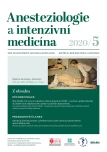Changes of endotheial glycocalyx layer after cadiopulmonary resuscitation in porcine model of cardiac arrest
Authors:
D.- Astapenko 1 3; R. Škulec 1,2,4,5; R. Černá Pařízková 1,2; N. Pinterová 6; T. Hovanec 2; T. Mlýnková 2; J. Dudáková 4; M. Bílská 5; T. Pařízek 5; V. Radochová 7; V.- Černý 1 3,5,8
Authors‘ workplace:
Klinika anesteziologie, resuscitace a intenzivní medicíny, Fakultní nemocnice Hradec Králové
1; Lékařská fakulta v Hradci Králové, Univerzita Karlova
2; Centrum pro výzkum a vývoj, Fakultní nemocnice Hradec Králové
3; Zdravotnická záchranná služba Středočeského kraje
4; Klinika anesteziologie, perioperační a intenzivní medicíny, Univerzita J. E. Purkyně v Ústí nad Labem, Masarykova nemocnice v Ústí nad Labem, Institut postgraduálního vzdělávání ve zdravotnictví Praha
5; Přírodovědecká fakulta v Praze, Univerzita Karlova
6; Fakulta vojenského zdravotnictví, Univerzita obrany v Brně
7; Dept. of Anesthesia, Pain Management and Perioperative Medicine, Dalhousie University, Halifax, Canada
8
Published in:
Anest. intenziv. Med., 31, 2020, č. 5, s. 212-216
Category:
Original Article
Overview
Objective: Endothelial glycocalyx (EG) plays key role in maintaining vascular integrity. Perturbation of the EG in patients after cardiac arrest has been described by measuring syndecan-1 and heparan sulphate levels. Non-invasive method of evaluating EG thickness by using Perfused Boundary Region (PBR) has been introduced recently. PBR represents the amount of lateral deviation of red blood cells towards the EG in µm. The aim of the study was to evaluate changes in PBR on porcine model of cardiac arrest in order to assess the usefulness of PBR as an indicator of glycocalyx damage.
Design: Experimental study on a porcine model of cardiac arrest.
Material and Methods: Cardiac arrest was induced by intracardiac electrode triggering ventricular fibrillation and treated by defibrillation after 15 minutes in accordance with 2015 ERC guidelines. Sublingual microcirculation was measured by hand-held microscope working on the principle of orthogonal spectral imaging and PBR was computed automatically with specialized software in three timepoints. At baseline (PBR_B), after return of spontaneous circulation (PBR_ROSC) and 20 minutes after ROSC (PBR_ROSC_20).
Results: PBR data was obtained from 11 pigs. There was insignificant increase of PBR after ROSC (p = 0.47). The PBR_B was 2.129 (± 0.21), PBR_ROSC was 2.206 (± 0.27) and PBR_ROSC_20 was 2.18 (± 0.19), data are presented as mean and standard deviation.
Conclusions: Our data demonstrate insignificant increase of PBR after cardiac arrest in pig. The value of PBR as an indicator of EG shedding requires further study before introducing this parameter as a routine non-invasive tool in pig model of cardiac arrest.
Keywords:
endothelial glycocalyx – Cardiac arrest – cardiopulmonary resuscitation
Sources
1. Reitsma S, Slaaf DW, Vink H, Marc AMJ van Zandvoort, Mirjam GA oude Egbrink. The endothelial glycocalyx: composition, functions, and visualization. Pflugers Arch 2007; 454(3): 345–359.
2. Nelson A, Johansson J, Tydén J, Bodelsson M. Circulating syndecans during critical illness. APMIS 2017; 125(5): 468–475.
3. Ushiyama A, Kataoka H, Iijima T. Glycocalyx and its involvement in clinical pathophysiologies. J Intensive Care 2016; 4(1): 59.
4. Cerny V, Astapenko D, Burkovskiy I, Hyspler R, Ticha A, Trevors MA, et al. Glycocalyx in vivo measurement. Clin Hemorheol Microcirc 2017; 67(3–4): 499–503.
5. Bass MD, Morgan MR, Humphries MJ. Syndecans shed their reputation as inert molecules. Sci Signal 2009; 2(64): pe18.
6. Martens RJH, Vink H, Oostenbrugge RJ Van, Staals J. Sublingual microvascular glycocalyx dimensions in lacunar stroke patients. Cerebrovasc Dis 2013; 35(5): 451–454.
7. Cerný V, Turek Z, Parízková R. Orthogonal polarization spectral imaging. Physiol Res 2007; 56(2): 141–147.
8. Grundmann S, Fink K, Rabadzhieva L, Bourgeois N, Schwab T, Moser M, et al. Perturbation of the endothelial glycocalyx in post cardiac arrest syndrome. Resuscitation 2012; 83(6): 715–720.
9. Monsieurs KG, Nolan JP, Bossaert LL, Greif R, Maconochie IK, Nikolaou NI, et al. European Resuscitation Council Guidelines for Resuscitation 2015. Resuscitation 2015; 95 : 1–80.
10. Goedhart PT, Khalilzada M, Bezemer R, Merza J, Ince C. Sidestream Dark Field (SDF) imaging: a novel stroboscopic LED ring-based imaging modality for clinical assessment of the microcirculation. Opt Express 2007; 15(23): 15101–15114.
11. Cerny V, Astapenko D, Brettner F, Benes J, Hyspler R, Lehmann Ch, et al. Targeting the endothelial glycocalyx in acute critical illness as a challenge for clinical and laboratory medicine. Crit Rev Clin Lab Sci 2017; 54(5): 343–357.
12. Callaway CW. Endothelial damage after cardiac arrest—„Endotheliitis.“ Resuscitation 2012; 83(6): 667–668.
13. Bro-Jeppesen J, Johansson PI, Hassager C, Wanscher M, Ostrowski SR, Bjerre M, et al. Endothelial activation/injury and associations with severity of post-cardiac arrest syndrome and mortality after out-of-hospital cardiac arrest. Resuscitation 2016; 107 : 71–79.
14. Hahn RG, Hasselgren E, Björne H, Zdolsek M, Zdolsek J. Biomarkers of endothelial injury in plasma are dependent on kidney function. Clin Hemorheol Microcirc 2019; 72(2): 161–168
15. Donati A, Damiani E, Domizi R, Romano R, Adrario E, Pelaia P, et al. Alteration of the sublingual microvascular glycocalyx in critically ill patients. Microvasc Res 2013; 90 : 86–89.
16. Astapenko D, Dostál P, Černá Pařízková R, Škulec R, Černý V. Analýza sublingvální mikrovaskulární glykokalyx u pacientů v intenzivní péči – prospektivní observační studie. Anest Intenziv Med 2019; 30(1): 14–21.
Labels
Anaesthesiology, Resuscitation and Inten Intensive Care MedicineArticle was published in
Anaesthesiology and Intensive Care Medicine

2020 Issue 5
Most read in this issue
- Use of rotational thromboelastometry in perioperative medicine and its comparison with standard coagulation testing
- Refusal of patient admission from pre-hospital care by the provider of acute inpatient care
- The importance and options of peroperative evaluation of nociception
- Fentanyl – 60 years since synthesis, history of opioid analgesics
